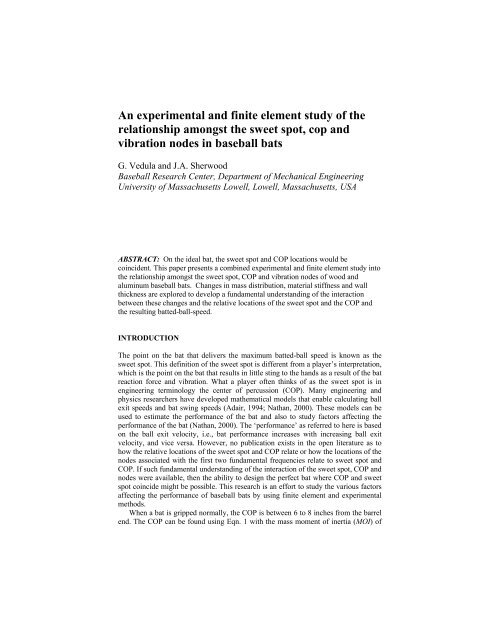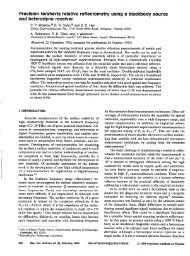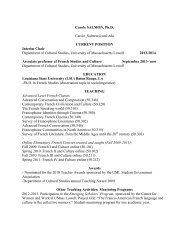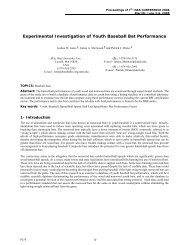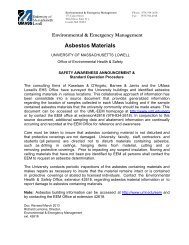An experimental and finite element study of the relationship amongst ...
An experimental and finite element study of the relationship amongst ...
An experimental and finite element study of the relationship amongst ...
Create successful ePaper yourself
Turn your PDF publications into a flip-book with our unique Google optimized e-Paper software.
<strong>An</strong> <strong>experimental</strong> <strong>and</strong> <strong>finite</strong> <strong>element</strong> <strong>study</strong> <strong>of</strong> <strong>the</strong><br />
<strong>relationship</strong> <strong>amongst</strong> <strong>the</strong> sweet spot, cop <strong>and</strong><br />
vibration nodes in baseball bats<br />
G. Vedula <strong>and</strong> J.A. Sherwood<br />
Baseball Research Center, Department <strong>of</strong> Mechanical Engineering<br />
University <strong>of</strong> Massachusetts Lowell, Lowell, Massachusetts, USA<br />
ABSTRACT: On <strong>the</strong> ideal bat, <strong>the</strong> sweet spot <strong>and</strong> COP locations would be<br />
coincident. This paper presents a combined <strong>experimental</strong> <strong>and</strong> <strong>finite</strong> <strong>element</strong> <strong>study</strong> into<br />
<strong>the</strong> <strong>relationship</strong> <strong>amongst</strong> <strong>the</strong> sweet spot, COP <strong>and</strong> vibration nodes <strong>of</strong> wood <strong>and</strong><br />
aluminum baseball bats. Changes in mass distribution, material stiffness <strong>and</strong> wall<br />
thickness are explored to develop a fundamental underst<strong>and</strong>ing <strong>of</strong> <strong>the</strong> interaction<br />
between <strong>the</strong>se changes <strong>and</strong> <strong>the</strong> relative locations <strong>of</strong> <strong>the</strong> sweet spot <strong>and</strong> <strong>the</strong> COP <strong>and</strong><br />
<strong>the</strong> resulting batted-ball-speed.<br />
INTRODUCTION<br />
The point on <strong>the</strong> bat that delivers <strong>the</strong> maximum batted-ball speed is known as <strong>the</strong><br />
sweet spot. This definition <strong>of</strong> <strong>the</strong> sweet spot is different from a player’s interpretation,<br />
which is <strong>the</strong> point on <strong>the</strong> bat that results in little sting to <strong>the</strong> h<strong>and</strong>s as a result <strong>of</strong> <strong>the</strong> bat<br />
reaction force <strong>and</strong> vibration. What a player <strong>of</strong>ten thinks <strong>of</strong> as <strong>the</strong> sweet spot is in<br />
engineering terminology <strong>the</strong> center <strong>of</strong> percussion (COP). Many engineering <strong>and</strong><br />
physics researchers have developed ma<strong>the</strong>matical models that enable calculating ball<br />
exit speeds <strong>and</strong> bat swing speeds (Adair, 1994; Nathan, 2000). These models can be<br />
used to estimate <strong>the</strong> performance <strong>of</strong> <strong>the</strong> bat <strong>and</strong> also to <strong>study</strong> factors affecting <strong>the</strong><br />
performance <strong>of</strong> <strong>the</strong> bat (Nathan, 2000). The ‘performance’ as referred to here is based<br />
on <strong>the</strong> ball exit velocity, i.e., bat performance increases with increasing ball exit<br />
velocity, <strong>and</strong> vice versa. However, no publication exists in <strong>the</strong> open literature as to<br />
how <strong>the</strong> relative locations <strong>of</strong> <strong>the</strong> sweet spot <strong>and</strong> COP relate or how <strong>the</strong> locations <strong>of</strong> <strong>the</strong><br />
nodes associated with <strong>the</strong> first two fundamental frequencies relate to sweet spot <strong>and</strong><br />
COP. If such fundamental underst<strong>and</strong>ing <strong>of</strong> <strong>the</strong> interaction <strong>of</strong> <strong>the</strong> sweet spot, COP <strong>and</strong><br />
nodes were available, <strong>the</strong>n <strong>the</strong> ability to design <strong>the</strong> perfect bat where COP <strong>and</strong> sweet<br />
spot coincide might be possible. This research is an effort to <strong>study</strong> <strong>the</strong> various factors<br />
affecting <strong>the</strong> performance <strong>of</strong> baseball bats by using <strong>finite</strong> <strong>element</strong> <strong>and</strong> <strong>experimental</strong><br />
methods.<br />
When a bat is gripped normally, <strong>the</strong> COP is between 6 to 8 inches from <strong>the</strong> barrel<br />
end. The COP can be found using Eqn. 1 with <strong>the</strong> mass moment <strong>of</strong> inertia (MOI) <strong>of</strong>
<strong>the</strong> bat about <strong>the</strong> center <strong>of</strong> mass (CG), <strong>the</strong> mass <strong>of</strong> <strong>the</strong> bat (m), <strong>and</strong> <strong>the</strong> distance (r)<br />
from <strong>the</strong> axis <strong>of</strong> rotation to <strong>the</strong> CG (Noble, 1998).<br />
COP =<br />
MOI<br />
(1)<br />
m × r<br />
The node point is <strong>the</strong> location on <strong>the</strong> bat where <strong>the</strong> amplitude <strong>of</strong> vibration is zero.<br />
The barrel node points <strong>of</strong> <strong>the</strong> first two fundamental vibrational modes are normally<br />
found at about 5 to 7 in from <strong>the</strong> barrel end. During an impact at <strong>the</strong> nodal location,<br />
<strong>the</strong>oretically minimal energy will be lost in <strong>the</strong> form <strong>of</strong> vibrations in <strong>the</strong> bat <strong>and</strong><br />
optimal energy will be imparted to <strong>the</strong> ball, yielding optimal ball exit velocity.<br />
<strong>An</strong>o<strong>the</strong>r important observation from a <strong>study</strong> by Van Z<strong>and</strong>t (1991) is that <strong>the</strong> ball exit<br />
velocity is relatively lower at any location o<strong>the</strong>r than <strong>the</strong> node point.<br />
From <strong>the</strong>se previous studies, it appears that ei<strong>the</strong>r <strong>the</strong> COP or <strong>the</strong> node point or<br />
both <strong>of</strong> <strong>the</strong>m toge<strong>the</strong>r have an effect on <strong>the</strong> sweet spot <strong>of</strong> <strong>the</strong> bat. A <strong>study</strong> by (Noble<br />
<strong>and</strong> Walker, 1994) demonstrated that in bats where <strong>the</strong> COP <strong>and</strong> node points are<br />
relatively close, impacts at ei<strong>the</strong>r <strong>of</strong> <strong>the</strong>se locations produced greater ball exit velocity<br />
than impacts at any o<strong>the</strong>r location. However, if <strong>the</strong> COP is moved away from <strong>the</strong><br />
node, impacts at <strong>the</strong> node point produced greater ball exit velocity than impacts at <strong>the</strong><br />
COP. On <strong>the</strong> ideal bat all <strong>the</strong>se <strong>of</strong> three points, i.e. <strong>the</strong> sweet spot, <strong>the</strong> COP <strong>and</strong> <strong>the</strong><br />
node points would coincide.<br />
METHODOLOGY<br />
Experimental methods were used to find <strong>the</strong> sweet spot, COP, 1 st <strong>and</strong> 2 nd natural<br />
frequencies <strong>and</strong> associated nodal locations in <strong>the</strong> barrel on metal <strong>and</strong> wood bats. The<br />
sweet spot was found using a hitting machine. The MOI was found using a pendulum<br />
test, <strong>and</strong> <strong>the</strong> COP was calculated from this MOI value. The frequencies <strong>and</strong> node<br />
points were found by conducting modal tests (accelerometer <strong>and</strong> impact hammer).<br />
Finite <strong>element</strong> models <strong>of</strong> <strong>the</strong>se bats were <strong>the</strong>n built <strong>and</strong> compared with <strong>the</strong><br />
<strong>experimental</strong> values, <strong>and</strong> <strong>the</strong> FE models were calibrated such that <strong>the</strong> mass, MOI <strong>and</strong><br />
natural frequencies <strong>of</strong> <strong>the</strong> FE models agreed with <strong>the</strong> <strong>experimental</strong> bats. The<br />
calibrated FE models were <strong>the</strong>n used to <strong>study</strong> how moving <strong>the</strong> COP <strong>and</strong> node points<br />
affected <strong>the</strong> location <strong>of</strong> <strong>the</strong> sweet spot <strong>and</strong> <strong>the</strong> associated batted-ball speed. The COP<br />
was moved by changing <strong>the</strong> MOI <strong>of</strong> <strong>the</strong> bat (i.e., changing <strong>the</strong> mass distribution <strong>of</strong><br />
bat) <strong>and</strong> <strong>the</strong> node points are displaced by changing <strong>the</strong> stiffness <strong>of</strong> <strong>the</strong> bat.<br />
HyperMesh was used as a preprocessor for building <strong>the</strong> <strong>finite</strong> <strong>element</strong> models,<br />
LS-DYNA was used for analysis <strong>and</strong> LS-POST <strong>and</strong> ETA-Post were used for<br />
postprocessing. The FE models <strong>of</strong> <strong>the</strong> solid wood bats were modeled using 8-noded<br />
brick <strong>element</strong>s <strong>and</strong> an Orthotropic-Elastic material. The aluminum bats are modeled<br />
using 4-noded shells <strong>and</strong> an Elastic material. The thickness at every inch on <strong>the</strong> metal<br />
bat was measured <strong>experimental</strong>ly using an acoustic method <strong>and</strong> was incorporated in<br />
<strong>the</strong> FE model. The ball model was built using <strong>the</strong> Viscoelastic material in LS-DYNA<br />
(Smith, 2001). The ball model was calibrated by impacting it against a stationary<br />
wood block <strong>and</strong> adjusting <strong>the</strong> properties <strong>of</strong> <strong>the</strong> model so that <strong>the</strong> coefficient <strong>of</strong><br />
restitution was 0.55. The bat-ball contact was modeled by using surface to surface<br />
contact option in LS-DYNA. The bat models were swung at an initial velocity <strong>of</strong> 85-<br />
mph tip speed, <strong>and</strong> <strong>the</strong> ball was pitched at 70 mph. The bat was impacted at five
locations; 5.0, 5.5, 6.0, 6.5 <strong>and</strong> 7.0 in from <strong>the</strong> tip <strong>of</strong> <strong>the</strong> barrel. The material<br />
properties for <strong>the</strong> bats <strong>and</strong> ball are summarized in Tables 1 through 3.<br />
Table 1 Aluminum Bat Properties (Elastic) (Sherwood et al., 2000).<br />
Young’s Modulus (psi) Density (lb/in 3 ) Poisson’s Ratio<br />
1e07 0.1 0.33<br />
Table 2 Wood Bat (Orthotropic-Elastic) (Sherwood et al., 2000).<br />
Young’s Modulus Density<br />
Shear Modulus<br />
(psi)<br />
(lb/in 3 Poisson’s Ratio<br />
)<br />
(psi)<br />
E1 E2 E3 Rho Pr1 Pr2 Pr3 G1 G2 G3<br />
2.5e06 9.0e05 1.7e05 0.026 2.7e-02 4.4e-02 6.7e-02 1.0e05 3.4e+05 1.3e+05<br />
Table 3 Ball Model (Shenoy et al., 2001).<br />
Mass Density Short-time Shear Long-time Shear<br />
Bulk Modulus<br />
(lb/in 3 Decay Constant<br />
) Modulus (psi) Modulus (psi)<br />
(psi)<br />
0.0276 4498 1492 5025 13495<br />
Using <strong>the</strong> FE models, MOI, CG, natural frequencies, node locations <strong>and</strong> COP<br />
values were obtained. The respective values for <strong>the</strong> baseline bat configurations are<br />
summarized in Tables 4 <strong>and</strong> 5. All values for MOI are about <strong>the</strong> CG.<br />
Table 4 Aluminum Bat Properties.<br />
Method<br />
Weight<br />
(oz)<br />
MOI<br />
(oz-in 2 )<br />
CG<br />
(in)<br />
Node 1<br />
(in)<br />
Node 2<br />
(in)<br />
COP<br />
(in)<br />
Sweet<br />
Spot<br />
(in)<br />
Mode 1<br />
(Hz)<br />
Mode 2<br />
(Hz)<br />
Exp 30.695 3248 12.50 6.69 5.00 5.50 5.50 200 700<br />
FEA 30.695 3198 12.06 7.00 5.25 5.56 5.50 198 710<br />
Table 5 Wood Bat Properties.<br />
Method<br />
Weight<br />
(oz)<br />
MOI<br />
(oz-in 2 )<br />
CG<br />
(in)<br />
Node 1<br />
(in)<br />
Node 2<br />
(in)<br />
COP<br />
(in)<br />
Sweet<br />
Spot<br />
(in)<br />
Mode 1<br />
(Hz)<br />
Mode 2<br />
(Hz)<br />
Exp 30.735 2324 10.88 6,56 4.94 6.26 6.50 156 508<br />
FEA 30.732 2334 10.94 6.75 4.75 6.42 6.00 149 500<br />
RESULTS<br />
Experimental <strong>and</strong> FE performance curves for 33-in aluminum <strong>and</strong> wood bats are<br />
shown in Figs. 1 through 4. The locations <strong>of</strong> <strong>the</strong> sweet spot, COP <strong>and</strong> node points<br />
with respect to <strong>the</strong> tip <strong>of</strong> <strong>the</strong> barrel are also marked on <strong>the</strong>se curves. Note that <strong>the</strong> FE<br />
results for batted-ball speeds <strong>of</strong> <strong>the</strong> wood <strong>and</strong> aluminum bats are greater than <strong>the</strong><br />
<strong>experimental</strong>ly measured values. These differences are significant <strong>and</strong> imply that <strong>the</strong><br />
FE model does not capture all <strong>of</strong> <strong>the</strong> energy dissipation associated with <strong>the</strong> bat-ball<br />
collision. However, as <strong>the</strong> FE models will be used for relative comparison <strong>of</strong> bat<br />
configurations, <strong>the</strong>se differences are considered to be unimportant for <strong>the</strong> current<br />
<strong>study</strong>.<br />
The performance curves in Figs. 1 through 4 show that <strong>the</strong> sweet spot is located<br />
between <strong>the</strong> fundamental node points <strong>and</strong> <strong>the</strong> COP. After <strong>the</strong> FE models were<br />
calibrated to agree with <strong>the</strong> <strong>experimental</strong> bats for MOI, CG <strong>and</strong> natural frequencies,<br />
<strong>the</strong> MOI <strong>of</strong> <strong>the</strong> metal bat FE model was altered by changing <strong>the</strong> mass distribution.<br />
Barrel-loaded (shell thickness is reduced by 5% <strong>and</strong> an additional 2-oz mass is added
to <strong>the</strong> barrel) <strong>and</strong> knob-loaded (shell thickness is reduced by 5% <strong>and</strong> an additional 2-<br />
oz mass is added to <strong>the</strong> knob) conditions were imposed on <strong>the</strong> metal bat model to<br />
displace <strong>the</strong> COP (Nathan, 2003). The sweet spot, COP <strong>and</strong> node points obtained<br />
from <strong>the</strong>se models are summarized in Table 6 <strong>and</strong> shown in Fig. 5.<br />
Ball Exit Velocity (MPH)<br />
100<br />
98<br />
96<br />
94<br />
92<br />
Sweet Spot<br />
& COP<br />
Node 1<br />
Node 2<br />
Trend Line<br />
Ball Exit Velocity (MPH)<br />
110<br />
108<br />
106<br />
104<br />
102<br />
Sweet Spot<br />
Node 1<br />
Node 2<br />
COP<br />
Trend Line<br />
90<br />
100<br />
4.5 5.0 5.5 6.0 6.5 7.0<br />
4.5 5.0 5.5 6.0 6.5 7.0<br />
Location from Barrel End (Inches) Location from Barrel End (Inches)<br />
Fig. 1 Aluminum-Experimental Fig. 2 Aluminum-FE Model<br />
98<br />
98<br />
97<br />
97<br />
96<br />
96<br />
95<br />
95<br />
Sweet Spot<br />
Node 1<br />
94<br />
Sweet Spot<br />
94<br />
Node 2<br />
Node 1<br />
COP<br />
93<br />
Node 2<br />
93<br />
Trend Line<br />
COP<br />
92<br />
Trend Line<br />
92<br />
91<br />
91<br />
90<br />
90<br />
4.5 5.0 5.5 6.0 6.5 7.0<br />
4.5 5.0 5.5 6.0 6.5 7.0<br />
Location from Barrel End (Inches) Location from Barrel End (Inches)<br />
Fig. 3 Wood Bat-Experimental Fig. 4 Wood Bat-FE Model<br />
Ball Exit Velocity (MPH)<br />
Ball Exit Velocity (MPH)
Table 6. MOI <strong>of</strong> <strong>the</strong> Metal Bat is Changed.<br />
Method<br />
Sweet Exit<br />
Weight MOI CG Node 1 Node 2 COP<br />
(oz) (oz-in 2 Spot Speed<br />
) (in) (in) (in) (in)<br />
(in) (mph)<br />
Original 30.695 3248 12.50 7.00 5.25 5.56 5.50 107.18<br />
Barrel<br />
Loaded<br />
30.695 3198 11.30 6.50 5.00 4.92 6.00 109.83<br />
Knob<br />
Loaded<br />
30.695 3440 13.70 7.25 5.50 5.65 7.00 106.04<br />
Table 5 shows that when <strong>the</strong> MOI is changed, <strong>the</strong> COP <strong>and</strong> <strong>the</strong> nodes are<br />
displaced from <strong>the</strong>ir original positions. It is also observed that <strong>the</strong> sweet spot also<br />
varies along with <strong>the</strong> node point <strong>and</strong> COP. For <strong>the</strong> barrel-loaded condition (additional<br />
mass is added to <strong>the</strong> barrel <strong>of</strong> <strong>the</strong> bat), <strong>the</strong> node points <strong>and</strong> COP moved closer <strong>the</strong><br />
barrel end. However, <strong>the</strong> sweet spot moved away from <strong>the</strong> tip by 0.5 in. When <strong>the</strong><br />
knob-loaded condition was imposed, <strong>the</strong> COP <strong>and</strong> <strong>the</strong> nodes moved away from <strong>the</strong><br />
barrel, <strong>and</strong> <strong>the</strong> sweet spot moved fur<strong>the</strong>r away from <strong>the</strong> barrel end <strong>and</strong> closer to node<br />
point. Also, for <strong>the</strong> knob-loaded condition, <strong>the</strong> distance between <strong>the</strong> COP <strong>and</strong> first<br />
node was greatest. Fig. 5 shows <strong>the</strong> performance curves for original, knob-loaded <strong>and</strong><br />
barrel-loaded models. The barrel-loaded model is observed to produce <strong>the</strong> greatest<br />
exit velocity. This result is expected because this configuration has <strong>the</strong> greatest<br />
concentration <strong>of</strong> mass in <strong>the</strong> vicinity <strong>of</strong> <strong>the</strong> impact.<br />
The stiffness <strong>of</strong> <strong>the</strong> metal bat was <strong>the</strong>n changed to see how it affects <strong>the</strong> COP <strong>and</strong><br />
node points. The stiffness <strong>of</strong> <strong>the</strong> model was altered by changing only <strong>the</strong> elastic<br />
modulus <strong>of</strong> <strong>the</strong> material. The frequencies were increased with <strong>the</strong> increase in<br />
elasticity, but <strong>the</strong>re was no change in <strong>the</strong> locations <strong>of</strong> <strong>the</strong> COP, nodes or sweet spot.<br />
However, for a 10% increase in elasticity, <strong>the</strong> ball exit velocity decreased by 1%. The<br />
performance curves are shown in Fig. 6.<br />
110<br />
110<br />
Ball Exit Velocity (MPH)<br />
109<br />
108<br />
107<br />
106<br />
Barrel-Loaded<br />
Original<br />
End-Loaded<br />
Ball Exit Velocity (MPH)<br />
109<br />
108<br />
107<br />
106<br />
E = 1.02e7<br />
E = 1.14e7<br />
E = 1.20e7<br />
105<br />
4.5 5.0 5.5 6.0 6.5 7.0<br />
Location from Barrel End (Inches)<br />
Fig. 5 Metal Bat-MOI Changed<br />
105<br />
4.5 5.0 5.5 6.0 6.5 7.0<br />
Location from Barrel End (Inches)<br />
Fig. 6 Metal Bat-Stiffness Changed
The thickness <strong>of</strong> <strong>the</strong> metal bat was <strong>the</strong>n varied to see how <strong>the</strong> COP <strong>and</strong> node point<br />
changed. The mass <strong>of</strong> <strong>the</strong> bat was kept constant by changing <strong>the</strong> material density. The<br />
results are shown in Table 7. There were no significant changes in COP <strong>and</strong> node<br />
point with change in ei<strong>the</strong>r <strong>the</strong> whole thickness <strong>of</strong> <strong>the</strong> bat or change in thickness <strong>of</strong> <strong>the</strong><br />
barrel, throat or h<strong>and</strong>le. However, <strong>the</strong> sweet spot was observed to be closer to <strong>the</strong><br />
node point. The ball exit velocity was observed to be increasing with decreasing shell<br />
thickness. Fig. 7 illustrates <strong>the</strong> same.<br />
In <strong>the</strong> case <strong>of</strong> wood bats, relatively big-barrel <strong>and</strong> relatively thin-h<strong>and</strong>le models<br />
were used to <strong>study</strong> <strong>the</strong> effect <strong>of</strong> COP <strong>and</strong> node points on sweet spot. There is no<br />
significant change between <strong>the</strong> COP <strong>and</strong> node points in ei<strong>the</strong>r case. However, it was<br />
observed that <strong>the</strong> ball exit velocity was greater with relatively big barrels <strong>and</strong><br />
relatively thin h<strong>and</strong>les, <strong>and</strong> vice versa. The results are shown in Table 8. The optimum<br />
wood bat has a relatively thin h<strong>and</strong>le <strong>and</strong> a relatively big barrel. It was observed that it<br />
is not possible to isolate <strong>and</strong> <strong>study</strong> <strong>the</strong> effect <strong>of</strong> ei<strong>the</strong>r COP or node point, as any<br />
method <strong>of</strong> changing one <strong>of</strong> <strong>the</strong>m will bring a change in o<strong>the</strong>r.<br />
Table 7. Changes in Aluminum Bat (30.70 oz).<br />
Method<br />
MOI<br />
(oz-in 2 )<br />
CG<br />
(in)<br />
Node 1<br />
(in)<br />
Node 2<br />
(in)<br />
COP<br />
(in)<br />
Sweet<br />
Spot<br />
(in)<br />
Exit<br />
Speed<br />
(mph)<br />
Original 3248 12.500 7.00 5.25 5.56 5.50 107.18<br />
Thick+10% 3190 12.03 7.25 5.25 5.36 6.00 105.04<br />
Thick-10% 3206 12.09 7.25 5.25 5.37 6.00 109.71<br />
Barrel-10% 3198 11.30 6.50 5.00 4.92 6.00 109.45<br />
Barrel-10% 3440 13.70 7.25 5.50 5.65 7.00 105.75<br />
Throat+10% 3187 12.04 7.25 5.25 5.38 6.00 105.86<br />
Throat-10% 3154 12.05 7.25 5.25 5.45 6.00 108.67<br />
H<strong>and</strong>le+10% 3359 12.12 7.25 5.25 5.06 6.00 106.23<br />
H<strong>and</strong>le-10% 2912 12.12 7.25 5.25 6.00 6.00 107.53<br />
110<br />
Ball Exit Velocity (MPH)<br />
109<br />
108<br />
107<br />
106<br />
Whole Bat<br />
Barrel<br />
Throat<br />
H<strong>and</strong>le<br />
105<br />
0.10 0.11 0.12 0.13<br />
Location from Barrel End (Inches)<br />
Fig. 7 Change in Shell Thickness vs. Performance
Table 8. Wood Bat Change in Diameter (30.73 oz).<br />
Method<br />
MOI<br />
(oz-in 2 )<br />
CG<br />
(in)<br />
Node 1<br />
(in)<br />
Node 2<br />
(in)<br />
COP<br />
(in)<br />
Sweet<br />
Spot<br />
(in)<br />
Exit<br />
Speed<br />
(mph)<br />
Original 2334 10.93 6.75 4.75 6.42 6.00 97.69<br />
Barrel+10% 2282 10.60 7.00 5.00 6.24 5.50 99.35<br />
Barrel-10% 2380 11.29 7.00 5.00 6.55 6.00 95.99<br />
H<strong>and</strong>le+10% 2526 11.49 7.00 5.00 6.40 5.50 95.98<br />
H<strong>and</strong>le-10% 2128 10.39 7.00 5.25 6.37 5.50 99.70<br />
H<strong>and</strong>le-10% +<br />
Barrel+10%<br />
CONCLUSIONS<br />
2006 10.25 6.75 4.75 6.19 5.50 100.06<br />
Finite <strong>element</strong> models <strong>of</strong> wood <strong>and</strong> metal baseball bats were built to <strong>study</strong> <strong>the</strong> effect<br />
<strong>of</strong> COP <strong>and</strong> node points on <strong>the</strong> sweet spot. It was observed that COP <strong>and</strong> node points<br />
move closer to <strong>the</strong> barrel for barrel-loading condition <strong>and</strong> away from barrel for knobloading<br />
condition. It is also observed that <strong>the</strong> sweet spot in both cases moved away<br />
from barrel <strong>and</strong> close to <strong>the</strong> node point. Increasing <strong>the</strong> aluminum bat stiffness by<br />
ei<strong>the</strong>r increasing <strong>the</strong> elastic modulus or <strong>the</strong> wall thickness resulted in a decrease in <strong>the</strong><br />
performance but did not bring any significant change in COP <strong>and</strong> node points. No<br />
clear relation among <strong>the</strong> relative locations <strong>of</strong> <strong>the</strong> sweet spot, COP <strong>and</strong> node points is<br />
concluded.<br />
REFERENCES<br />
Adair R.K. (1994) The Physics <strong>of</strong> Baseball, Harper-Collins, New York.<br />
Nathan A.M. (2000) Dynamics <strong>of</strong> <strong>the</strong> baseball-bat collision. American Journal <strong>of</strong><br />
Physics, 68(11). pp.979-990.<br />
Nathan A.M. (2003) Characterizing <strong>the</strong> performance <strong>of</strong> baseball bats. American<br />
Journal <strong>of</strong> Physics, 71(2). pp.134-143.<br />
Noble L. (1998) Inertial <strong>and</strong> Vibrational Characteristics <strong>of</strong> S<strong>of</strong>tball <strong>and</strong> Baseball<br />
Bats: Research <strong>and</strong> Design Implication. 16th Symposium <strong>of</strong> <strong>the</strong> International<br />
Society <strong>of</strong> Biomechanics in Sports Vol. II, pp. 86-97.<br />
Noble L. <strong>and</strong> Walker. H (1994) Baseball Bat Inertial <strong>and</strong> Vibrational Characteristics<br />
<strong>and</strong> discomforts following Ball-Bat Impacts. Journal <strong>of</strong> Applied Biomechanics 10<br />
pp.132-144.<br />
Smith L.V. (2001) Evaluating Baseball Bat Performance. Journal <strong>of</strong> Sports<br />
Engineering, Vol. 4.<br />
Van Z<strong>and</strong>t (1991) The Dynamical Theory <strong>of</strong> Baseball Bat. American Journal <strong>of</strong><br />
Physics 60. pp.72.<br />
Sherwood J.A, Mustone, T.J., <strong>and</strong> Fallon, L.P. (2000) Characterizing <strong>the</strong><br />
Performance <strong>of</strong> Baseball Bats using Experimental <strong>and</strong> Finite Element Methods,<br />
3rd International Conference on <strong>the</strong> Engineering <strong>of</strong> Sport, June, Sydney, Australia.<br />
Shenoy M.M., Smith L.V., Axtell.J.T, (2001) Performance assessment <strong>of</strong> wood, metal<br />
<strong>and</strong> composite baseball bats. Composite Structures 52 pp. 397-404.


